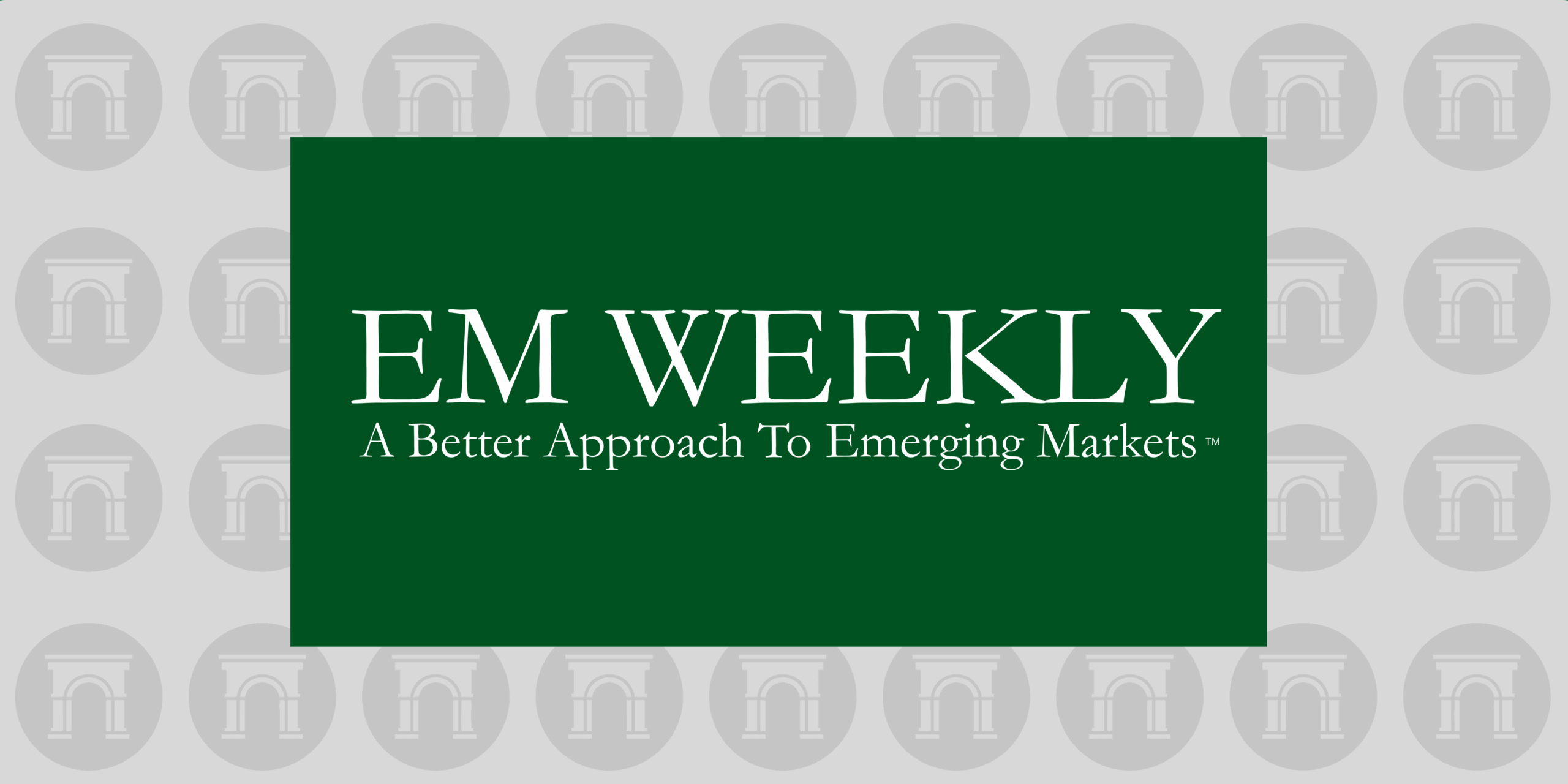Contents
Market Overview
Macro Update
Markets responded positively this week to the de-escalation in U.S.-China trade tensions—a 90-day truce that includes a mutual rollback of proposed new tariffs to 30% on China and 10% on the U.S. While temporary, this development eased fears of a worst-case economic outcome. U.S. equities rebounded toward pre-Liberation Day levels, with the S&P 500 turning positive for the year, and the 10-year Treasury yield rising 10bps to 4.45%. Yet the U.S. dollar remained under pressure, unable to break above the 102 level on the DXY, and ended the week below 101. Bilaterally, EUR/USD was broadly stable, trading around 1.12.
Economic data this week continued to send mixed signals. Retail sales growth slowed meaningfully in April, rising just 0.1% month-over-month—down from an upwardly revised 1.7% in March—with the pullback likely concentrated in categories heavily exposed to Chinese imports. Initial jobless claims remained steady at 229,000, slightly above expectations, while industrial production was flat after a -0.3% reading in March. More notably, factory output declined by 0.4%, marking its first contraction in six months and underscoring the vulnerability of U.S. manufacturing amid ongoing trade uncertainty. The University of Michigan consumer sentiment survey index fell to 50.8 in preliminary May results, the second lowest on record and well below expectations of 53.4; the year-ahead expected inflation climbed to 7.3%, the highest level since 1981.
On the inflation front, headline CPI came in softer than expected, rising 0.2% month-over-month and 2.3% year-over-year in April. A concurrent decline in the producer price index offered some relief to those concerned about companies preemptively passing on tariff-related cost increases. Still, many analysts expect inflationary pressures to build into the summer, as firms may find it increasingly difficult to absorb higher input costs without raising prices. Reflecting this concern, Walmart’s management cautioned on its first-quarter earnings call that even after the recent tariff reductions, import duties on Chinese goods remain “too high” and are likely to pressure margins and consumer prices.
Geopolitically, President Donald Trump’s high-profile Middle East tour yielded several headlines. In Saudi Arabia, he secured a $600 billion “strategic economic partnership” with Crown Prince Mohammed bin Salman. President Trump also met with Syria’s new President Ahmed al-Sharaa—despite Israeli objections—and announced the lifting of U.S. sanctions to provide the country with what he called “a chance at greatness.” These developments, along with tentative signs of progress toward a U.S.-Iran agreement, triggered a pullback in oil prices, which had been rallying earlier in the week and briefly approached $67 per barrel. Brent ultimately settled closer to $64.
A proposed U.S.-brokered summit between Ukraine and Russia’s Presidents failed to materialize, with lower-level delegations dispatched instead. Meanwhile, a ceasefire between India and Pakistan held, providing a rare patch of stability in another flashpoint region.
Elsewhere, UK GDP grew by 0.7% quarter-over-quarter and 1.3% year-over-year, beating expectations in the run-up to U.S. trade actions, though UK exporters still face a 10% U.S. tariff. Germany’s investor confidence rebounded sharply in May, and April inflation came in at 2.1% year-over-year, matching forecasts. In Japan, preliminary data on 1Q GDP showed that the economy contracted 0.7% on an annualized basis, driven by weaker trade activity and consumer spending, raising the specter of technical recession. Industrial production fared better, improving to 0.2% month-over-month in March, from -1.1% in the prior month.
In emerging markets, Mexico’s Central Bank cut rates by 50bps, citing external risks, while Ecuador saw an ally of President Daniel Noboa elected to head the National Assembly, potentially boosting reform prospects.
Looking ahead, markets remain vulnerable to abrupt shifts in trade, monetary, and foreign policy. The week’s developments provided some relief and helped avert a near-term spiral. Yet, with economic indicators sending mixed signals and policy still erratic, investors would be wise to remain both opportunistic and cautious, particularly as key signposts on inflation, labor markets, and Fed communication take center stage in coming weeks.
EM Credit Update
EM hard currency sovereign debt returned 0.5%, driven by the high yield segment which continued to recover this week, returning 1.1% as risk sentiment turned more clearly positive. In comparison, the return for EM investment grade sovereigns was slightly negative, down 0.1% again. Sovereign spreads tightened by 13bps overall, driven by a 26bps tightening in high yield vs. only 4bps for investment grade.
Africa drove sovereign returns again this week, with oil-linked credits like Angola and Gabon outperforming. Other high beta credits such as Pakistan and Ecuador also outperformed this week as risk appetite returned. Low beta sovereign credits underperformed this week.
EM local currency sovereign performance was slightly negative again this week, down 0.1%, as the dollar gained some ground. South African local bonds outperformed on the back of risk-on sentiment stemming from U.S.-China tariff reprieve as well as the South African Reserve Bank’s possible update to its inflation-target framework. Czech local bonds underperformed this week as its Central Bank gave cautious forward guidance following cutting the policy rate to 3.5% and the CZK was affected by a marginally weaker EUR.
EM corporates lagged sovereigns slightly this week, delivering a return of 0.3% at the index level, driven by a return of 0.7% for the high yield segment vs. only 0.1% for investment grade. Corporate spread moves were also more muted with overall spreads tighter by 9bps, driven by a 15bps tightening in high yield vs. only 5bps for investment grade.
Primary market activity continued to be busy in the corporate space this week with 12 corporate issuers tapping the market. There was no new sovereign issuance this week.
The Week Ahead
The week ahead includes a presidential runoff vote in Romania, the first round of presidential elections in Poland, general elections in Portugal, and the Qatar Economic Forum, as well as rate decisions in Australia, Indonesia, and Nigeria. Following Walmart’s warning about upcoming price increases, other U.S. consumer bellwethers such as Home Depot, Lowe’s, and Target are due to release 1Q earnings and provide guidance. During the annual Amelia Island conference in Florida, various Fed speakers will provide views on the economic path ahead, given the trade truce. G-7 Finance Ministers and Central Bank Governors will meet in Canada, and the ECB will publish minutes from its April policy meeting.
Chile, Mexico, Thailand, Singapore, and Germany will report GDP figures, while CPI numbers will be released in the euro area, Canada, UK, South Africa, Malaysia, Japan, and Singapore. PMIs will be reported in the euro area, France, Germany, UK, Japan, and India. Retails sales in China, South Africa, Canada as well as euro area consumer confidence will provide clues on the strength of global consumer demand, while Taiwan’s export orders and industrial demand could offer a peek into early trade war impact. In the U.S., markets will see the leading economic index, new home sales, and building permits, as China releases data on property prices, industrial production, and loan prime rates.
Fixed Income
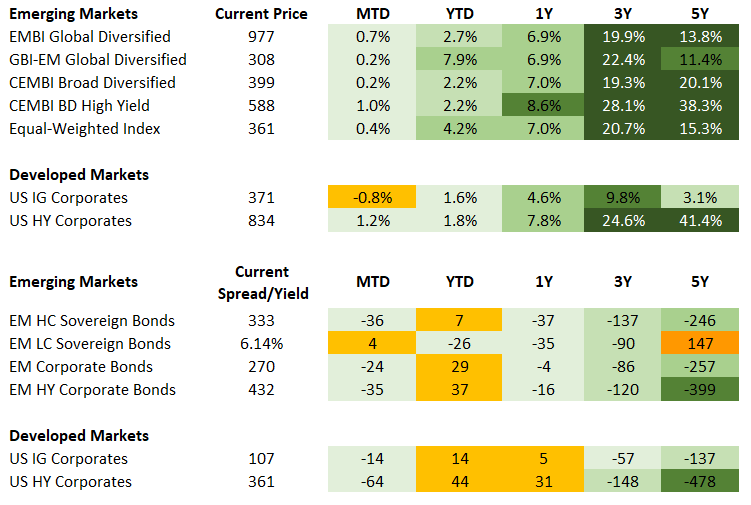
Equities
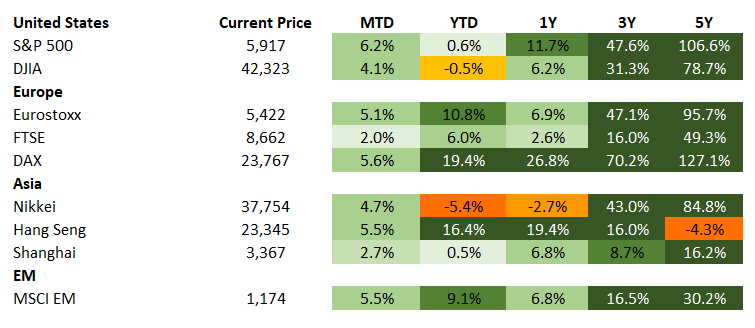
Commodities

Source for data tables: Bloomberg, JPMorgan, Gramercy. EM Fixed Income is represented by the following JPMorgan Indicies: EMBI Global, GBI-EM Global Diversified, CEMBI Broad Diversified and CEMBI Broad High Yield. DM Fixed Income is represented by the JPMorgan JULI Total Return Index and Domestic High Yield Index. Fixed Income, Equity and Commodity data is as of May 16, 2025 (mid-day).
Highlights
U.S.-China Temporary Tariff Reprieve Lifts Near-Term Growth Floor
Event: Geneva talks led to a reduction in the U.S. total effective tariff rate on China’s imports to around 39%, and China’s total effective tariff rate on U.S. imports to roughly 30%. Additionally, China committed to remove or suspend non-tariff countermeasures taken against the U.S. since April 2nd. Authorities from both sides agreed to a structured process for ongoing dialogue. Markets responded positively and analysts lifted China growth forecasts and moderated their expectation for a U.S. recession.
Gramercy Comment: The better-than-expected outcome of U.S.-China talks and lower tariff rates relative to ‘Liberation Day’ reduces most severe downside economic risks for now, but we believe U.S. recession odds and uncertainty are still elevated. If current tariffs are upheld through 2025, China’s economy is likely able to achieve 4.0-4.5% growth without material upsize in stimulus. Conversely, if talks fall apart and tariffs move back up, we continue to expect Chinese authorities to respond with larger-scale economic support. We expect volatility and uncertainty to pick back up as the 90-day pause nears its end in mid-August, and we acknowledge the complexities of reaching a more durable deal in that timeframe.
Zelenskiy–Putin Meeting in Istanbul Fails to Materialize
Event: In line with Gramercy’s expectations, there were slim hopes for a U.S.-brokered face-to-face meeting in Türkiye between the Ukrainian and Russian leaders for the first time since Russia’s full-scale invasion of Ukraine, and the meeting failed to materialize. Lower-level delegations met to explore the possibility of a temporary ceasefire but achieved only an agreement on a prisoner swap. President Trump, who is in the region on his Middle East tour and suggested that he might stop in, also decided to skip the meeting. He said there will be no tangible progress until he meets with President Putin. This put Ukraine and Europe in an uncomfortable geopolitical position yet again.
Gramercy Comment: This week’s developments confirm Gramercy’s long-standing call that the two sides remain too far apart for any reasonable peace prospects. After it was announced that President Putin did not plan to travel to Istanbul for face-to-face negotiations with President Volodymyr Zelenskiy, who was already in Türkiye, Ukraine’s leader refused to meet with Russia’s lower-level delegation that was dispatched for the talks and mandated his defense minister lead the discussions over a “possible ceasefire”. On the Russian side, the head of Moscow’s delegation, Vladimir Medinsky, suggested that Russia was “ready to discuss possible compromises”, but the outcome of the two sides only agreeing a prisoner swap indicates that no real compromises were on the table.
The Kremlin’s refusal to budge from its “maximalist objectives” is the main reason why we have argued consistently that an end to the conflict is not realistic in the near-term. Russia’s current demands are tantamount to Ukraine’s full capitulation and therefore are “non-starters” for Kyiv and its European allies. Any material compromise by Moscow to unlock the impasse would represent a dramatic departure from the Kremlin’s strategy thus far, so we remain skeptical. With talks in Türkiye failing to produce any significant progress, it is now critical to see which side will be blamed by the Trump Administration. In addition, we will be watching if Ukraine can continue to rely on limited support by Washington in the form of intelligence sharing and arms sales to third parties (i.e., Europe).
Pakistan Receives IMF Disbursement and Reaches Ceasefire with India
Event: The IMF Board approved the first review of Pakistan’s Extended Fund Facility Arrangement and disbursed roughly $1 billion to the authorities. The board also approved the government’s request for a $1.4 billion facility to support efforts to build economic resilience to climate vulnerabilities and natural disasters. Shortly thereafter, India and Pakistan agreed to a ceasefire following serious military escalation and tit-for-tat strikes catalyzed by a terrorist attack in the disputed Kashmir region last month. Pakistan bonds rallied over the week.
Gramercy Comment: The IMF board approval and military ceasefire was in line with our expectations and helps re-anchor the near-term credit outlook. While the impact of the suspension of the Indus Waters Treaty should be limited this year, it could be greater over time as India ramps up hydro projects and refines ability to restrict water flows. The first effects could be seen later this year as the dry winter planting season gets underway. In the meantime, markets will watch for any negotiations over the treaty, as well as the next IMF review, in September.
President Noboa’s Ally Elected President of Ecuador’s National Assembly
Event: In its inaugural session, Ecuador’s newly sworn-in National Assembly elected Niels Olsen, a former Minister of Tourism under Presidents Noboa and Guillermo Lasso, and a current lawmaker from Noboa’s National Democratic Action (AND) party, as its President for the next two years.
Gramercy Comment: Mr. Olsen’s election is a significant victory for President Noboa and a credit-positive development for Ecuador. Having a trusted ally at the helm of the National Assembly ensures that President Noboa’s reform agenda has a high probability of avoiding the traditional legislative bottlenecks of recent years and provides improved governability prospects for the second Noboa Administration. This boosts the government’s chances to continue fiscal consolidation and cooperation with IMF program targets amid a challenging external backdrop, including depressed oil prices – a key factor for budget revenues in Ecuador. Olsen obtained 80 votes, with 64 against and six abstentions in the 151-seat legislature. As we have argued before, a majority of around 80 votes gives President Noboa a level of governability not seen in Ecuador’s fractured political landscape in recent years and represents a structural credit improvement. In addition, we think that a working majority in the new assembly significantly reduces President Noboa’s incentives to seek elections for a Constituent Assembly, which could re-introduce a political uncertainty that would be unwelcome from a market perspective.
Emerging Markets Technicals
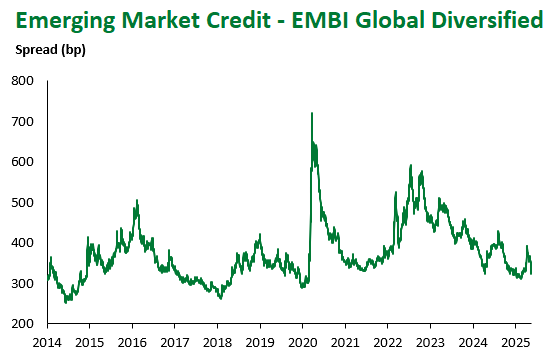
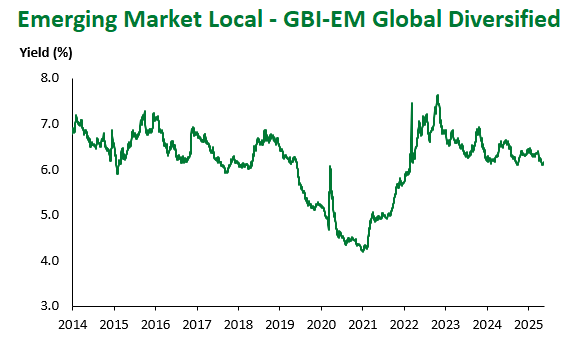
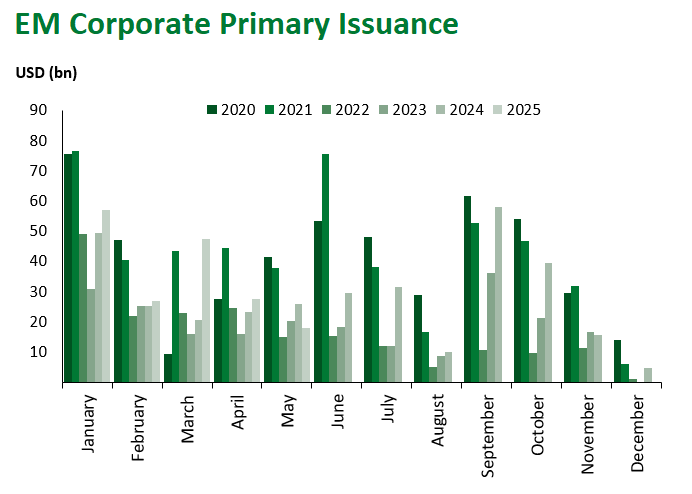
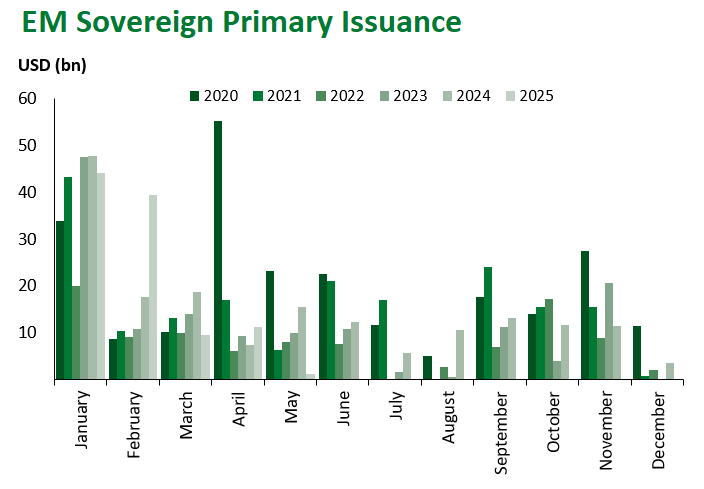
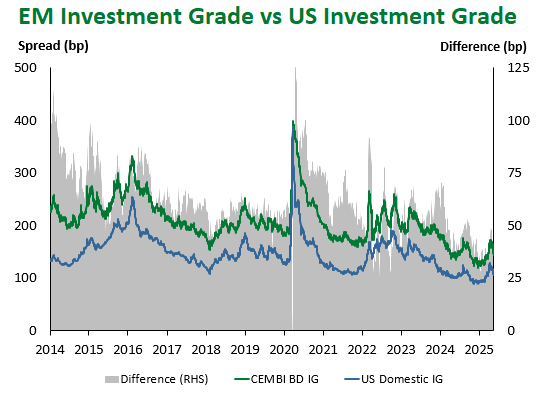
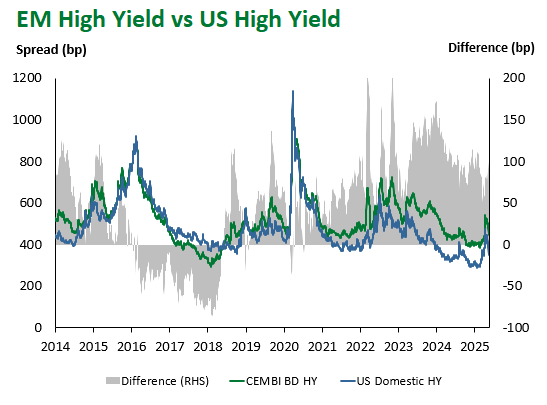
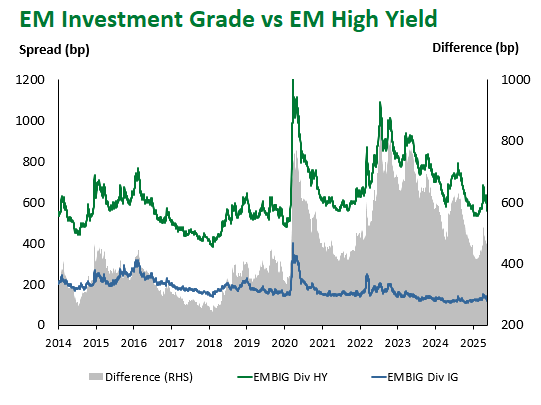
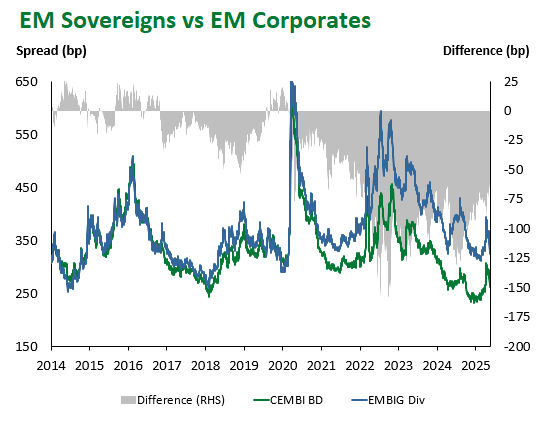
Emerging Markets Flows
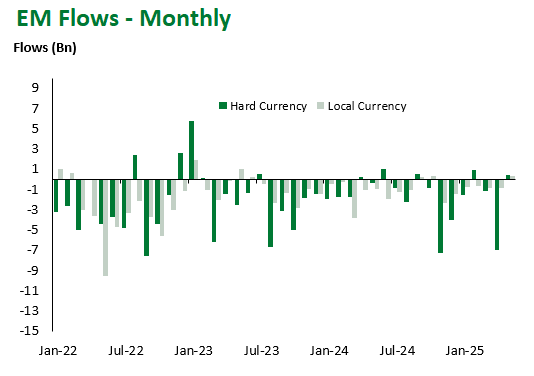
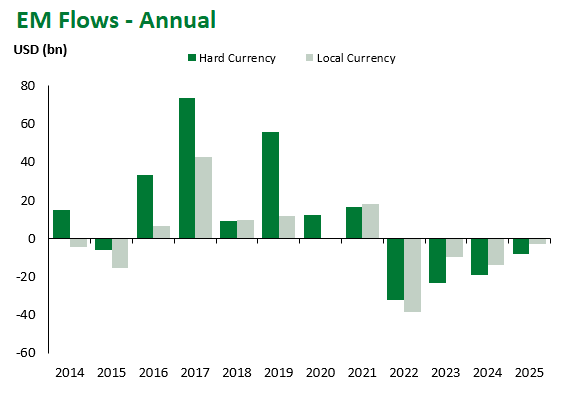
Source for graphs: Bloomberg, JPMorgan, Gramercy. As of May 16, 2025.
For questions, please contact:
Kathryn Exum, CFA ESG, Director, Co-Head of Sovereign Research, [email protected]
Petar Atanasov, Director, Co-Head of Sovereign Research, [email protected]
This document is for informational purposes only. The information presented is not intended to be relied upon as a forecast, research or investment advice, and is not a recommendation, offer or solicitation to buy or sell any securities or to adopt any investment strategy. Gramercy may have current investment positions in the securities or sovereigns mentioned above. The information and opinions contained in this paper are as of the date of initial publication, derived from proprietary and nonproprietary sources deemed by Gramercy to be reliable, are not necessarily all-inclusive and are not guaranteed as to accuracy. This paper may contain “forward-looking” information that is not purely historical in nature. Such information may include, among other things, projections and forecasts. There is no guarantee that any forecasts made will come to pass. Reliance upon information in this paper is at the sole discretion of the reader. You should not rely on this presentation as the basis upon which to make an investment decision. Investment involves risk. There can be no assurance that investment objectives will be achieved. Investors must be prepared to bear the risk of a total loss of their investment. These risks are often heightened for investments in emerging/developing markets or smaller capital markets. International investing involves risks, including risks related to foreign currency, limited liquidity, less government regulation, and the possibility of substantial volatility due to adverse political, economic or other developments. References to any indices are for informational and general comparative purposes only. The performance data of various indices mentioned in this update are updated and released on a periodic basis before finalization. The performance data of various indices presented herein was current as of the date of the presentation. Please refer to data returns of the separate indices if you desire additional or updated information. Indices are unmanaged, and their performance results do not reflect the impact of fees, expenses, or taxes that may be incurred through an investment with Gramercy. Returns for indices assume dividend reinvestment. An investment cannot be made directly in an index. Accordingly, comparing results shown to those of such indices may be of limited use. The information provided herein is neither tax nor legal advice. Investors should speak to their tax professional for specific information regarding their tax situation.
